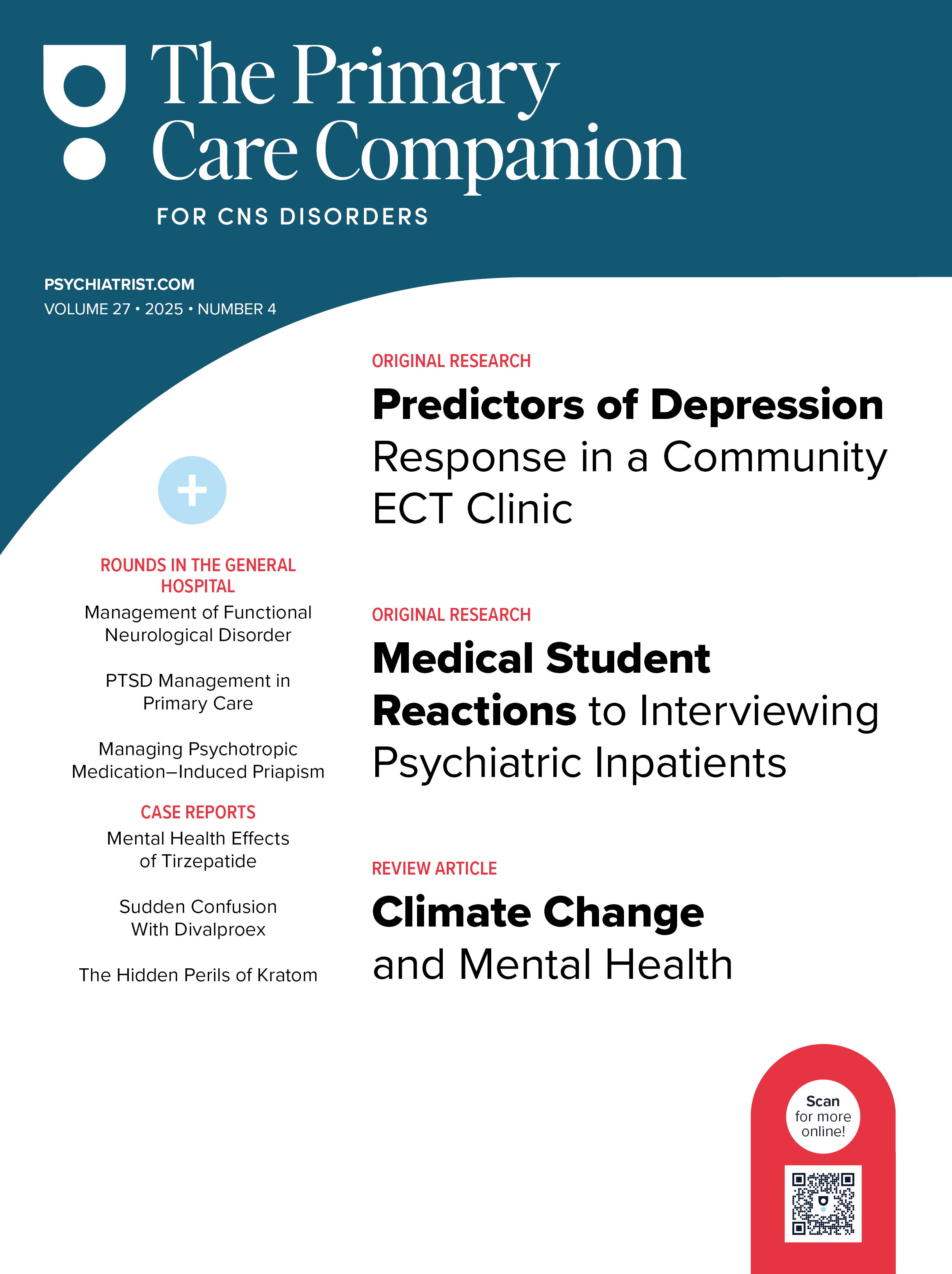Nystagmus as a Discontinuation Symptom After Antidepressant Therapy: A Case Report
To the Editor: I present a patient with recurrent depression who experienced remission on a fixed daily dose of 150 mg of venlafaxine in the first episode and 15 mg of escitalopram in the second episode. Postural nystagmus appeared after discontinuation of treatment in each episode.
Case report. Mr A, a 56-year-old married man, had a 6-year history of recurrent major depressive disorder (MDD) according to the DSM-5. His first episode had begun by January 2007 when he was 50 years old. His depressive symptoms began to appear slowly and were characterized by depressed mood, irritability, diminished interest and pleasure in his everyday activities, loss of appetite, lack of energy, poor concentration, early morning waking, and recurrent thoughts such as, “It is not interesting being alive.” These symptoms led to impaired work and social functioning. His parents and sister had a history of symptoms of depression. Extended-release venlafaxine was started with 37.5 mg/d and was increased gradually to 150 mg/d in 4 weeks with no adverse effects. The patient experienced important symptomatic relief by week 4 and reached remission in 8 weeks. Functionality was completely restored by August 2007. For the next 18 months, Mr A was on the same treatment regimen with full MDD remission.
Remarkably, 10 days after completion of slow antidepressant discontinuation (ie, taper for 2 months), Mr A, who had no medical history of eye problems, started experiencing position vertical and lateral nystagmus, usually at its worst in the morning. The symptom was ameliorated during the day, almost disappearing by night. No other visual problem was related by the patient or detected. The symptom persisted for 3 weeks but disappeared slowly at the end of the fifth week.
In January 2010, MDD reappeared, characterized by similar symptoms as previously described but with the emergence of symptoms of anxiety and fatigue (both severely worsening in the morning) and serious impairment of social functioning. Escitalopram was administered at 5 mg/d, reaching 15 mg/d in 3 weeks with no unwanted effects. After 6 weeks, depression had remitted. During follow-up (18 months), there was no relapse. After slow discontinuation of escitalopram for 6 weeks, the patient experienced nystagmus with the same characteristics as described earlier, disappearing by 4 to 5 weeks.
The literature includes only 1 report of positional nystagmus associated with amitriptyline withdrawal.1 There is another case report of a patient who manifested signs of serotonin syndrome during an intravenous anesthetic with remifentanil and propofol. The patient displayed nystagmus, lower extremity clonus, and diaphoresis. At the time of surgery, the patient was being treated with 60 mg of fluoxetine for severe MDD. His symptoms resolved in the surgical care unit without incident.
Investigators have shown that fluoxetine2,3 and sertraline4 can induce oculomotor abnormalities during sleep in depressed patients. It is suggested that these abnormalities are likely to be the result of increased availability of serotonin5,6 and secondary dopaminergic effects.7-9
As the use of antidepressants continues to increase, the incidence of withdrawal symptoms is also likely to increase. Patients treated with antidepressants should be questioned specifically during the discontinuation phase about the presence of this unwanted effect. It is important to recognize its clinical features as well as the benign course after a few weeks of follow-up.
References
1. Osborne SF, Vivian AJ. Primary position upbeat nystagmus associated with amitriptyline use. Eye (Lond). 2004;18(1):106. PubMed doi:10.1038/sj.eye.6700529
2. Armitage R, Trivedi M, Rush AJ. Fluoxetine and oculomotor activity during sleep in depressed patients. Neuropsychopharmacology. 1995;12(2):159-165. PubMed doi:10.1016/0893-133X(94)00075-B
3. Geyer JD, Carney PR, Dillard SC, et al. Antidepressant medications, neuroleptics, and prominent eye movements during NREM sleep. J Clin Neurophysiol. 2009;26(1):39-44. PubMed doi:10.1097/WNP.0b013e318196046f
4. Zhang B, Hao Y, Jia F, et al. Sertraline and rapid eye movement sleep without atonia: an 8-week, open-label study of depressed patients. Prog Neuropsychopharmacol Biol Psychiatry. 2013;47:85-92. PubMed doi:10.1016/j.pnpbp.2013.08.010
5. Baloh RW, Dietz J, Spooner JW. Myoclonus and ocular oscillations induced by l-tryptophan. Ann Neurol. 1982;11(1):95-97. PubMed doi:10.1002/ana.410110117
6. Schenck CH, Mahowald MW, Kim SW, et al. Prominent eye movements during NREM sleep and REM sleep behavior disorder associated with fluoxetine treatment of depression and obsessive-compulsive disorder. Sleep. 1992;15(3):226-235. PubMed
7. Tychsen L, Sitaram N. Catecholamine depletion produces irrepressible saccadic eye movements in normal humans. Ann Neurol. 1989;25(5):444-449. PubMed doi:10.1002/ana.410250505
8. Schiller PH, Tehovnik EJ. Neural mechanisms underlying target selection with saccadic eye movements. Prog Brain Res. 2005;149:157-171. PubMed doi:10.1016/S0079-6123(05)49012-3
9. Van Nechel C. Oculomotor anomalies from medications [in French]. Bull Soc Belge Ophtalmol. 2007;304(304):179-184. PubMed
Author affiliation: Department of Psychiatry, Federal University of São Paulo/Escola Paulista de Medicina—UNIFESP, São Paulo, Brazil.
Potential conflicts of interest: None reported.
Funding/support: None reported.
Published online: April 3, 2014.
Prim Care Companion CNS Disord 2014;16(2):doi:10.4088/PCC.13l01615.
© Copyright 2014 Physicians Postgraduate Press, Inc.




